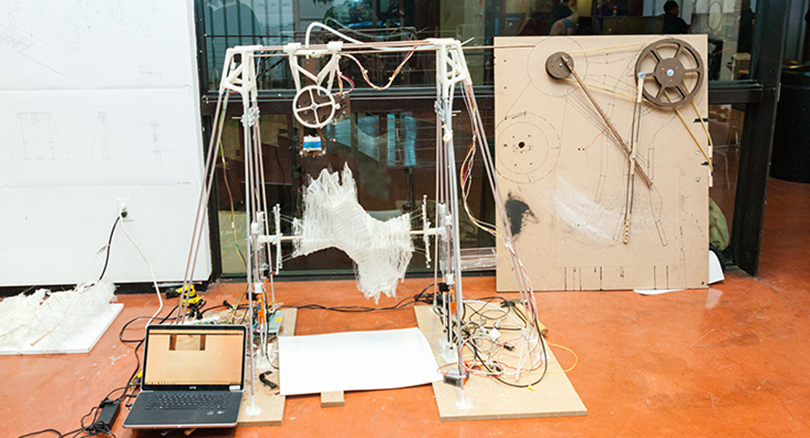
A new studio in the School of Architecture is giving undergraduate architecture students the opportunity to develop and build their own machines to use as tools for generating architectural ideas. Called Designing Machines that Design, the studio is unusual in schools of architecture and the first of its kind at Pratt, leading students to discover new ways of thinking and approaching design by authoring their own design machines instead of using standard software or fabrication technologies. The class launched in fall 2016 with a group of 14 fourth and fifth year architecture students taught by Undergraduate Architecture Associate Professor Duks Koschitz and Adjunct Assistant Professor Che-Wei Wang.
The tools students normally use for design, such as commercially available animation and modeling software, incorporate the built-in biases of their developers that can influence the design process. Creating their own design tools in the studio allowed the students to transcend these biases. Working in pairs, they used a range of materials and technologies to develop machines driven by motors, swinging weights, and other mechanisms. The next step was to conduct experiments that explored the possibilities of what the machines could generate, from 2D drawings to 3D shapes made of sand, wax, and other materials. They chose one of the resulting ideas to develop into an architectural design proposal for a final project.
“Most architectural studios focus on the final end goal or problem to solve, but in this class we could select any number of possible applications for the ideas that were generated,” said Grey Wartinger (B.Arch. ’17). “The open-ended aspect of this studio was really valuable, and I’m still learning from all the work that we did,” he added. Wartinger and Andrew Martens (B.Arch. ’17), who built an analog drawing machine and a motor-driven machine, focused on exploring pathways and patterns using sand as a material. Their final project integrated the idea of a labyrinth into a building design.
Other final projects included memorial designs by Jacob Hedaya (B.Arch. ’18) and Tom Xia (B.Arch. ’18) that grew out of initial experiments with their pendulum-powered drawing machine. Teammates Sergey Pigach (B.Arch. ’17) and Bryce Taylor (B.Arch. ’18) designed a building stairway that was informed by the voids, or empty spaces, generated from experiments that involved inputting several materials at the same time into their motor-driven machine.
“The studio requires students to observe, evaluate, and make decisions repeatedly, which helps them to develop critical thinking skills that they will use throughout their careers,” said Koschitz.
They also develop practical skills by working with different types of prototyping design technologies. “Students get the chance to write software, work with electronics, or learn to use a range of other tools to build their devices, and it gives them confidence to feel they can make almost anything,” Wang explained.
The studio will be offered again in fall 2017. See videos from the class showing experiments using machines created by David Franck (B.Arch. ’18) and Adin Rimland (B.Arch. ’18) and Ada Mitchev (B.Arch. ’17) and Colin Cawthorne (B.Arch. ’17).